Switching from messy email threads and scattered files to a streamlined client portal is a game-changer for efficiency and client satisfaction. But with dozens of platforms promising the same thing, how do you find the one that truly fits your business? The endless search for the best client portal software can be overwhelming, leading to analysis paralysis and wasted time.
This guide cuts through the noise. We've done the heavy lifting to evaluate, compare, and rank the top solutions available today. You'll get a detailed breakdown of the 12 best options, moving beyond marketing claims to provide an honest look at what each platform does well and where it falls short. We'll dive into the features that matter most: automated workflows, custom branding, security and compliance, and essential third-party integrations.
Whether you're a legal firm managing sensitive documents, an HR team onboarding new hires, or a real estate agency closing deals, finding the right portal is a critical step. Implementing the right tool is a strategic move to significantly enhance overall client interactions, contributing directly to a better way to improve customer experience and build loyalty.
Inside this comprehensive review, you will find:
- In-depth analysis of each platform with pros and cons.
- Direct comparisons of key features and pricing structures.
- Screenshots and direct links to help you evaluate each option.
- Recommendations tailored to specific industries like legal, finance, and transportation.
Our goal is to give you the clarity needed to choose a portal that not only solves your document collection headaches but also delivers a professional, secure, and modern experience for your clients. Let’s get started.
1. Superdocu
Superdocu positions itself as a premier choice in the best client portal software landscape, transforming slow, manual document collection into a streamlined, automated, and secure workflow. It is particularly effective for businesses that rely on repeatable, high-volume document intake, such as onboarding new clients, processing applications, or verifying compliance paperwork. The platform’s core strength lies in its ability to save significant administrative time, claiming it can reduce collection time by up to 70% and save teams over 30 hours per month.
This is achieved through a user-friendly, drag-and-drop workflow builder and an extensive library of industry-specific templates for legal, real estate, HR, and transportation sectors. Teams can quickly create and deploy branded, secure client portals where customers can upload required files from any device. The system automates tedious follow-ups with customizable reminders and tracks document expiration dates, ensuring all information remains current without constant manual intervention.
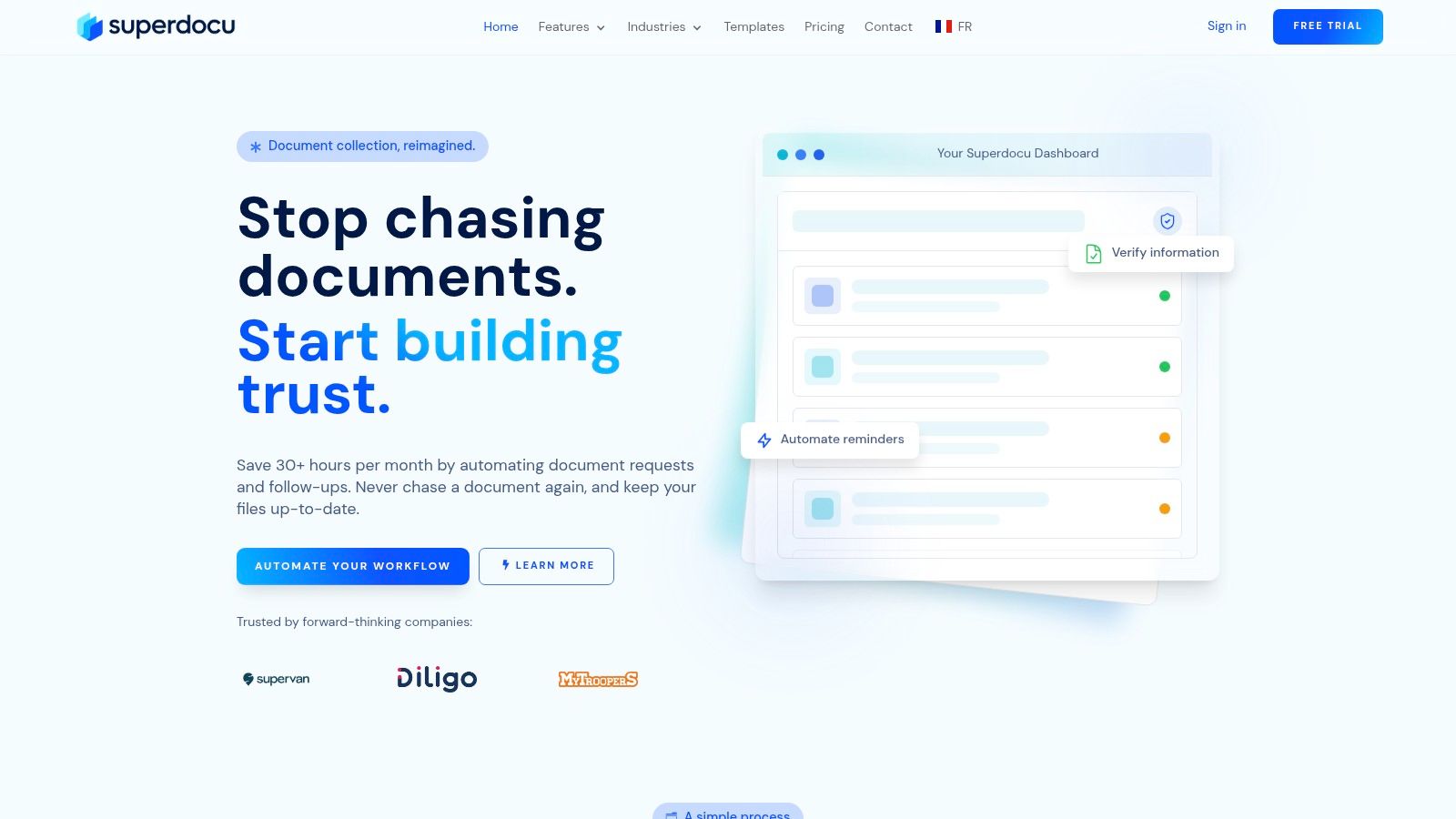
Key Features & Analysis
Superdocu stands out with its deep automation capabilities and robust security framework. The integration with Zapier unlocks connections to over 3,000 applications, enabling businesses to trigger document requests directly from their CRM or push collected data into spreadsheets automatically. A native DocuSign integration seamlessly incorporates eSignature steps into the workflow, consolidating signed documents within the platform.
Security is a foundational element. All data is encrypted and hosted in European data centers with triple redundancy, ensuring high availability and strict GDPR compliance. This makes it an ideal choice for regulated industries or businesses serving European clients.
Pricing Structure
Superdocu offers transparent, tiered pricing designed for growing businesses:
- Starter: 97 €/month for up to 100 active contacts, 2 team users, and 20 GB of storage.
- Pro: 247 €/month, increasing limits to 300 active contacts, 20 users, 50 GB of storage, and adding Zapier and DocuSign integrations.
- Enterprise: Custom plans offering API access, unlimited users, and advanced features like automated document validation.
All plans include a 7-day free trial.
Pros and Cons
Pros:
- Rapid Automation: The workflow builder and templates enable fast creation and reuse of secure document request flows.
- Powerful Integrations: Zapier and DocuSign support complex, automated workflows without needing custom code.
- Strong Security & Compliance: GDPR-compliant, Europe-based hosting provides peace of mind for sensitive data.
- Excellent Client Experience: White-labeled portals and branded emails offer a professional, seamless user journey.
Cons:
- Tiered Usage Limits: Lower-tier plans have caps on active contacts and storage, which may be restrictive for high-volume teams.
- Gated Advanced Features: API access and automated validation are reserved for Enterprise-level customers.
Website: https://www.superdocu.com/en
2. SuiteDash
SuiteDash is an all-in-one business software that aims to replace a dozen different tools with a single, integrated platform. It’s designed for businesses that want a fully white-labeled client portal deeply connected to their internal operations, including CRM, project management, and billing. This makes it one of the most comprehensive options on the market.
Its primary strength lies in its "everything included" model. Instead of patching together various apps, SuiteDash provides a unified environment where you can manage client communications, share files, send invoices, assign tasks, and even host courses, all under your own brand. This comprehensive approach is what makes it a contender for the best client portal software for agencies and service businesses seeking a single source of truth.
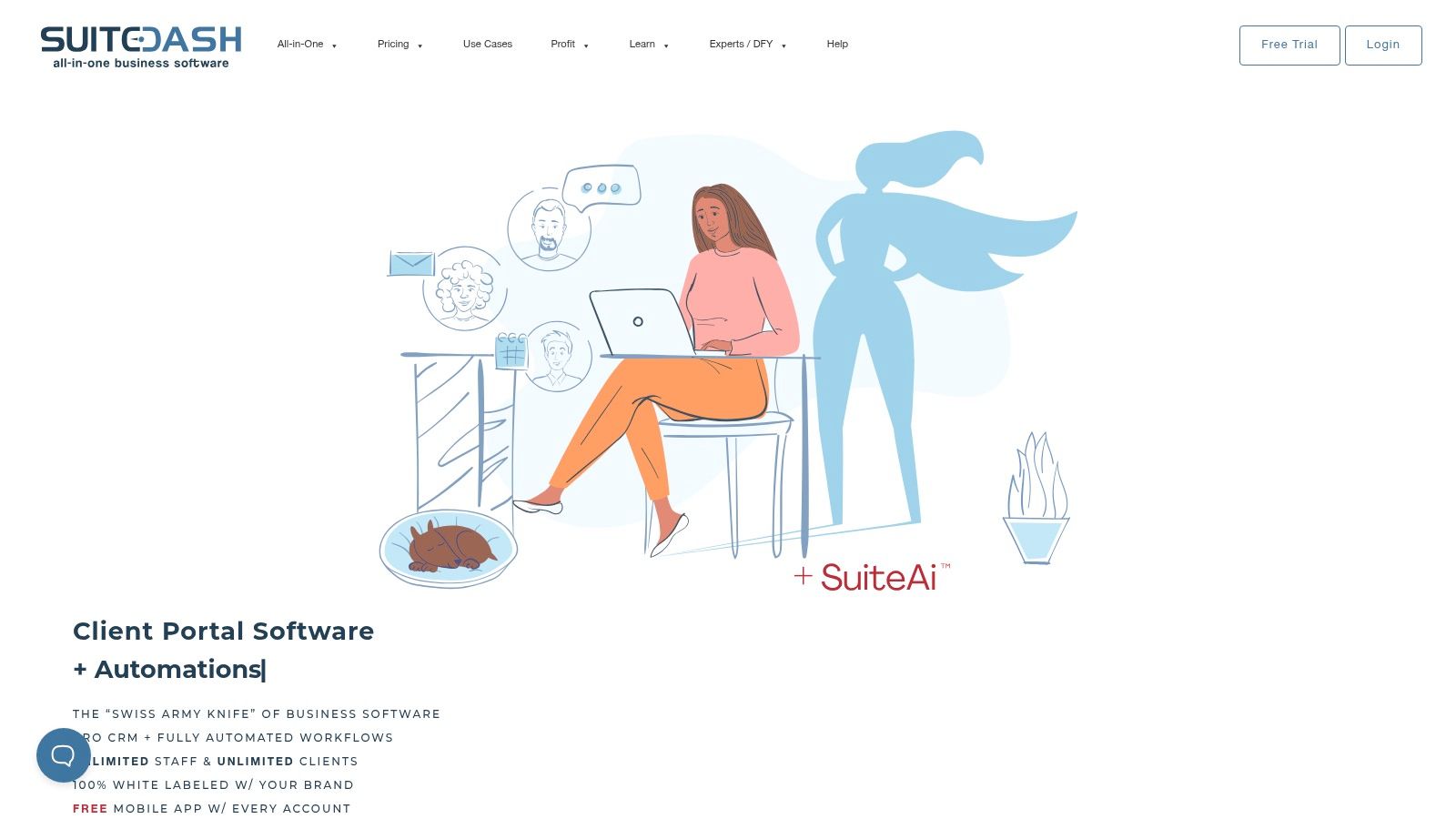
Key Features & User Experience
SuiteDash is packed with features, but the user experience can be dense for beginners due to the sheer number of options. Non-technical teams might face a steeper learning curve during the initial setup.
- Fully White-Label Portal: Customize everything from the login screen URL to the color schemes and logos. Learn more about how to set up a white-label client portal.
- Integrated Toolset: Combines CRM, project management, invoicing, contracts, e-signatures, and file sharing in one place.
- Automation Engine: Create powerful workflows that trigger actions based on client activities, form submissions, or project milestones.
- Unlimited Everything: All plans include unlimited staff and client accounts, which is a major cost advantage for growing teams.
Pros and Cons
| Pros | Cons |
|---|---|
| All-in-one platform replaces multiple software subscriptions. | Steep learning curve due to the extensive feature set. |
| Flat-rate pricing with unlimited clients and staff on all plans. | The interface can feel overwhelming and less modern than competitors. |
| Highly customizable and fully white-labeled experience. | Best for those who will use most features; otherwise, it's overkill. |
Website: https://suitedash.com
3. Clinked
Clinked is a secure, white-label client portal platform designed for professional service firms that prioritize security, compliance, and structured collaboration. It offers a clean and intuitive environment where businesses can manage client interactions, share sensitive documents, and track project progress with full audit trails. This focus on enterprise-grade security and a user-friendly interface makes it ideal for financial services, legal firms, and corporate teams.
Its primary strength is balancing robust features with simplicity, ensuring clients can onboard and collaborate with minimal friction. Unlike all-in-one solutions that can feel overwhelming, Clinked provides a focused toolset for secure communication and document management. This dedicated approach positions it as one of the best client portal software options for organizations that need a compliant, easy-to-use hub for high-stakes client relationships.
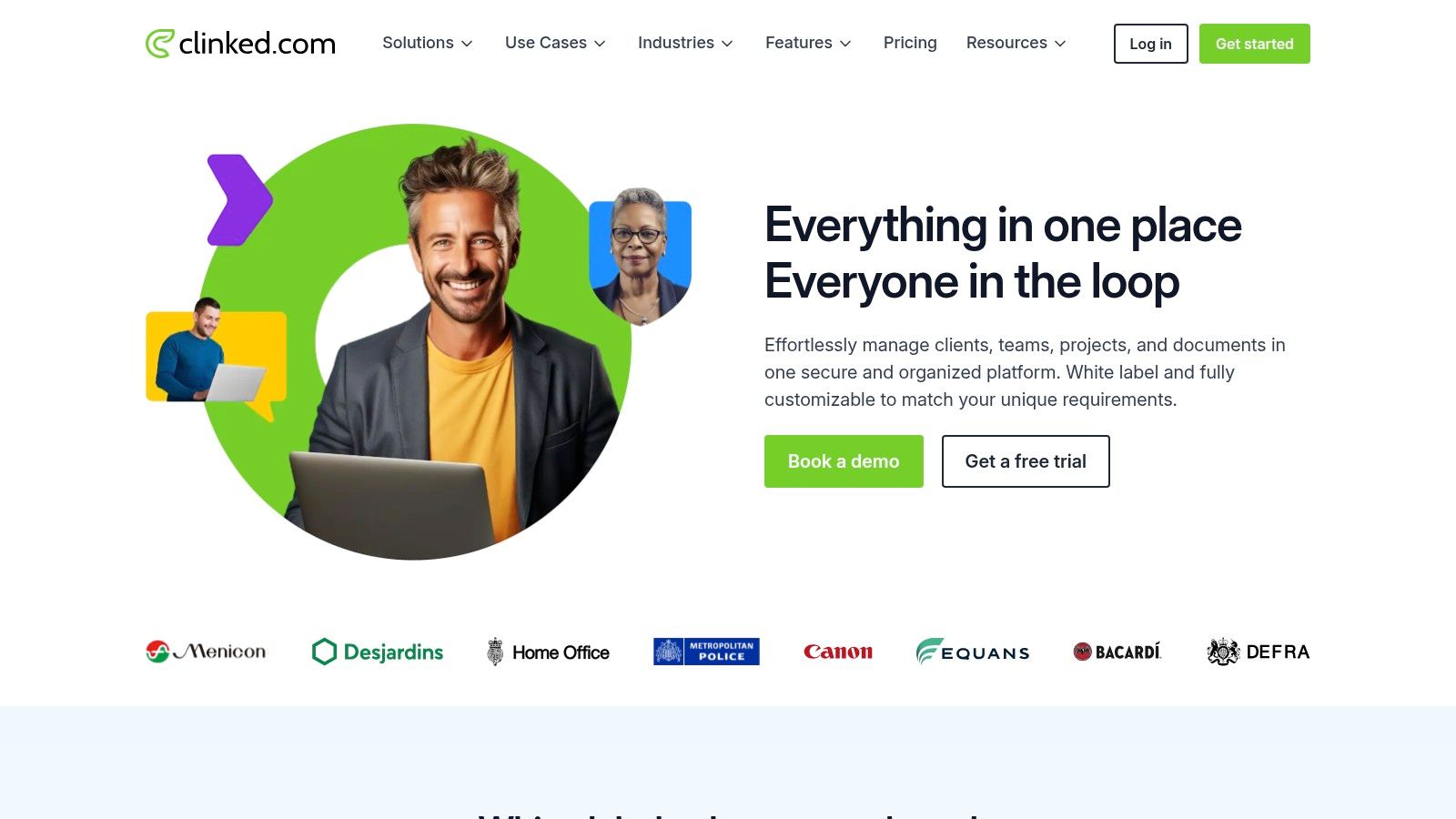
Key Features & User Experience
Clinked offers a straightforward and modern user experience that simplifies client collaboration. Its mobile apps are mature and provide a seamless experience for clients on the go, which is a significant advantage for user adoption.
- Enterprise-Grade Security: Features include two-factor authentication (2FA), ISO 27001 certification, GDPR alignment, detailed audit trails, and document watermarking.
- Full White-Labeling: Customize the portal with your own domain, logo, colors, and even launch branded mobile apps for iOS and Android.
- Collaboration Tools: Includes integrated group chat, discussions, task management, shared calendars, and file approval workflows.
- Key Integrations: Connects with essential tools like Google Workspace, DocuSign, Zoom, and thousands more through Zapier.
Pros and Cons
| Pros | Cons |
|---|---|
| Excellent security and compliance features ideal for regulated industries. | Higher entry pricing than some SMB-focused tools. |
| Mature and intuitive mobile apps enhance client experience. | Member and storage caps on plans require careful selection. |
| Clear public pricing with defined storage and member limits. | Less of an all-in-one platform; more focused on portal features. |
Website: https://www.clinked.com
4. Moxo
Moxo is a modern client interaction platform designed for high-touch service businesses that need to manage complex workflows and maintain strong compliance. It focuses on structuring the entire client journey, from onboarding to ongoing service, within a secure, branded portal. This makes it a powerful choice for financial services, consulting, and other professional service firms.
Its core strength is the combination of a streamlined client experience with robust, back-end workflow automation. Moxo provides a one-stop hub where clients can message you, sign documents, complete tasks, and join video meetings, eliminating the need to juggle emails and various third-party apps. This structured approach to client management helps it stand out as one of the best client portal software options for organizations prioritizing process and security.

Key Features & User Experience
Moxo offers a clean, app-like interface that is intuitive for clients, even those who are not tech-savvy. The platform feels professional and is built to handle sensitive interactions securely.
- Workflow Automation: Use a drag-and-drop builder with conditional logic to automate multi-step processes like client onboarding or project approvals.
- One-Stop Client Hub: Integrates secure messaging, file sharing, video meetings, e-signatures, and task management into a single client-facing portal.
- Comprehensive Security: Features include detailed audit trails, role-based access, and SSO, making it suitable for regulated industries.
- Private-Labeled Mobile Apps: Offers the option to create a fully branded mobile app for your business, providing a premium client experience.
Pros and Cons
| Pros | Cons |
|---|---|
| Strong workflow automation and compliance features. | Quote-based pricing can be less transparent than competitors. |
| Premium branding options, including private-label mobile apps. | Add-ons and advanced branding features can significantly increase costs. |
| Scales effectively from small teams to large enterprise needs. | May be too complex for simple use cases focused only on file sharing. |
Website: https://www.moxo.com
5. Ideagen Huddle
Ideagen Huddle is a secure client portal designed for high-stakes external collaboration, particularly in regulated industries and the public sector. Its core focus is on providing a compliant, auditable environment for document sharing, co-authoring, and file requests. This makes it an excellent SharePoint alternative for organizations that prioritize government-grade security and strict version control.
The platform excels where compliance is non-negotiable. With options like a FedRAMP-approved version, Huddle offers peace of mind for legal firms, government contractors, and financial institutions. It isn't just a place to store files; it's a controlled workspace for co-editing documents, managing task lists, and requesting information from clients with a full audit trail. This security-first approach is why it's considered one of the best client portal software solutions for compliance-heavy workflows.
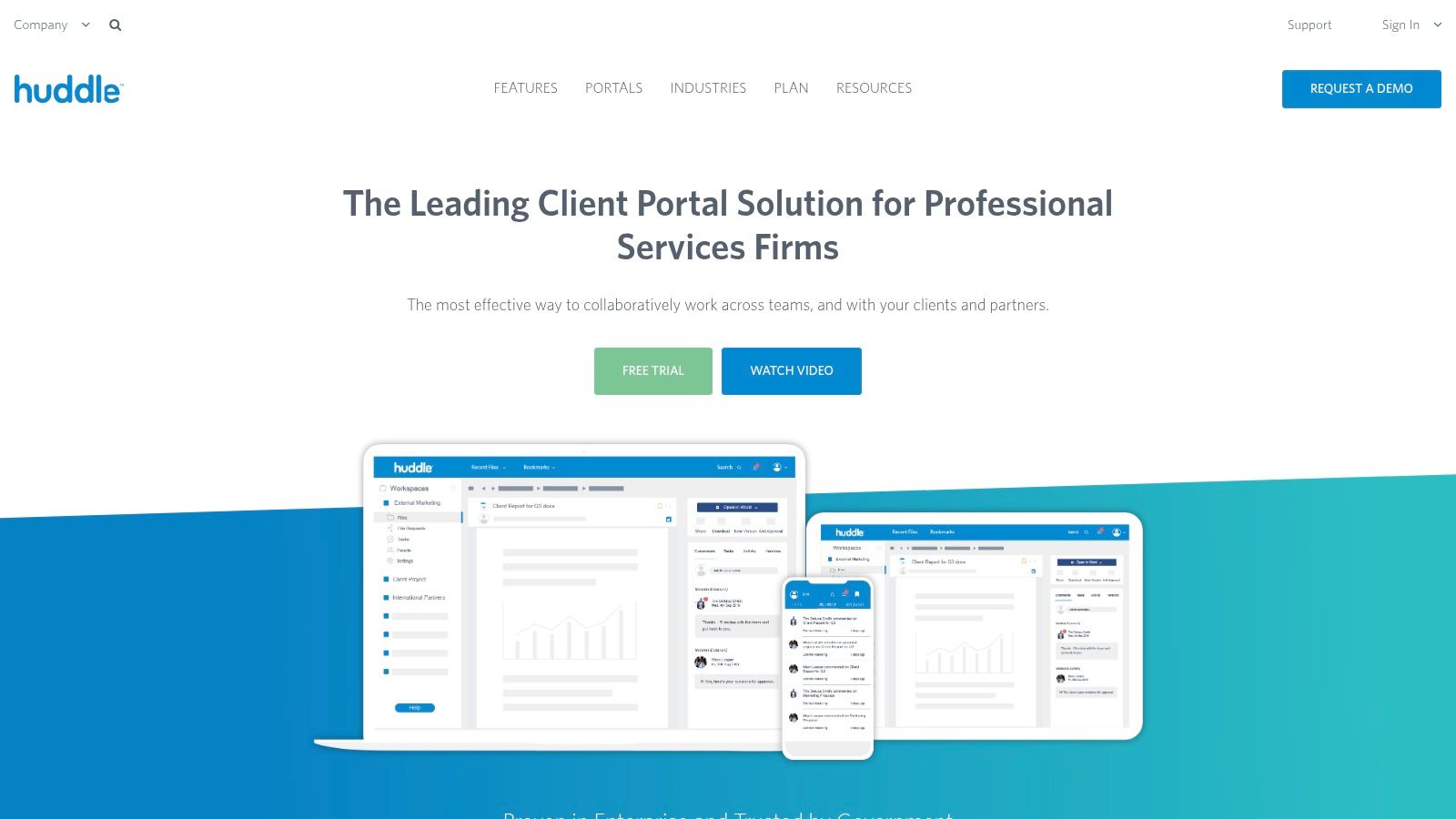
Key Features & User Experience
Huddle’s user experience is straightforward, focusing on secure document management rather than an all-in-one business suite. This makes it relatively easy for clients to adopt, as the interface is clean and centered around familiar file and task management.
- Government-Grade Security: Offers a FedRAMP-certified option, making it suitable for collaboration with public sector entities.
- Document Collaboration: Features include file requests with version control, Microsoft Office Online co-editing, and full audit trails.
- Granular Permissions: Provides precise control over who can view, edit, and download specific files and folders within a client workspace.
- Client-Branded Workspaces: Customize portals with your branding to create a professional and seamless client experience.
Pros and Cons
| Pros | Cons |
|---|---|
| Compliance-focused with a FedRAMP option for regulated firms. | Pricing is by request, indicating an enterprise-level sales process. |
| Strong document collaboration and version control workflows. | May be overkill and too expensive for small teams with basic needs. |
| Simple client signup and excellent support for large files. | Lacks the integrated CRM and billing features of all-in-one platforms. |
Website: https://huddle.ideagen.com
6. Salesforce Experience Cloud (Customer Community/Portal)
Salesforce Experience Cloud is an enterprise-grade platform for building customer portals directly on top of the Salesforce CRM. It is designed for businesses that need a deep, native connection between their client-facing portal and their core sales, service, and marketing data. This direct integration allows for powerful automation and a unified view of the customer journey.
Its primary strength lies in leveraging the entire Salesforce ecosystem. You can create branded, self-service portals where clients can manage their accounts, create support cases, access a knowledge base, and interact with your team. This makes it a top contender for the best client portal software for organizations already invested in Salesforce and looking to extend their CRM capabilities directly to their clients.
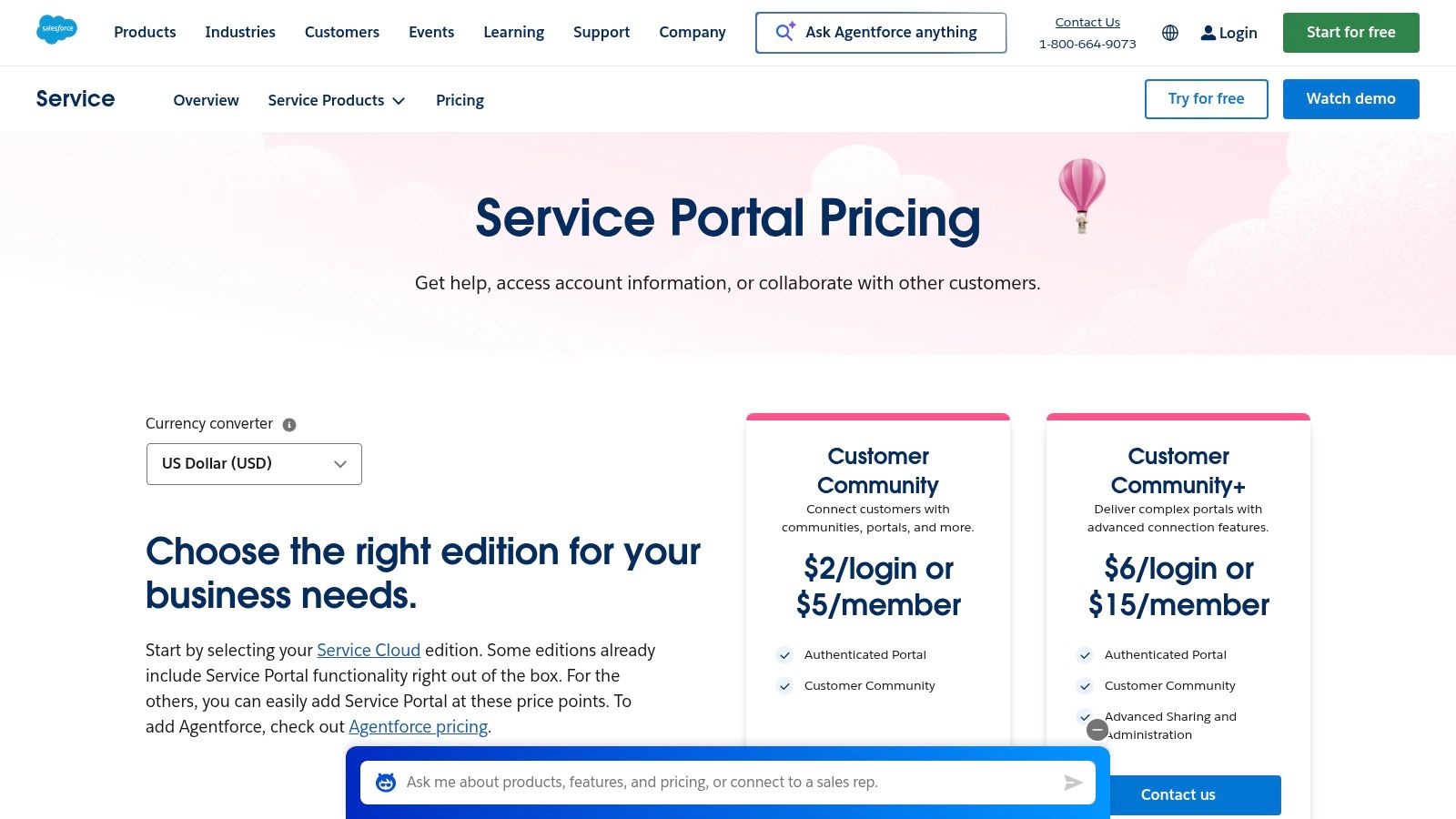
Key Features & User Experience
Experience Cloud offers powerful customization but requires dedicated Salesforce administration expertise to set up and maintain. The user experience is highly configurable, allowing businesses to create tailored digital experiences for different customer segments.
- Native Salesforce Integration: Portals are built directly on your CRM data, ensuring real-time information sync for contacts, cases, and accounts. Learn more about how a client portal works.
- Templates and Components: Start with pre-built templates for customer service and account management, then customize with drag-and-drop components.
- Advanced Security and Roles: Leverage Salesforce’s robust security model to control data visibility with granular roles and permissions.
- Flexible Licensing: Pricing models are based on either named users (members) or the number of logins, providing cost flexibility for different usage patterns.
Pros and Cons
| Pros | Cons |
|---|---|
| Seamless integration with Salesforce data and automation. | Requires Salesforce stack and specialized admin expertise. |
| Highly extensible through the vast AppExchange ecosystem. | Costs can scale quickly with usage, add-ons, and customizations. |
| Flexible licensing matches different user engagement patterns. | Can be overly complex for businesses not already using Salesforce. |
Website: https://www.salesforce.com/service/customer-self-service/pricing/
7. HubSpot Service Hub (Customer Portal)
HubSpot Service Hub is a customer service platform deeply integrated with the powerful HubSpot CRM. It offers a customer portal designed to streamline support, enhance transparency, and empower clients with self-service options. Instead of focusing on complex project management, HubSpot’s portal centers on ticketing, knowledge base access, and direct communication, making it a strong choice for businesses prioritizing customer support and service delivery.
Its primary strength lies in its connection to the broader HubSpot ecosystem. For businesses already using HubSpot for marketing or sales, adding the Service Hub creates a unified view of the entire customer journey. This integration allows support teams to have full context on client history, making interactions more efficient and personalized. This focus on a seamless CRM-driven support experience makes it a contender for the best client portal software for SMBs that need scalable, ticket-based client interaction.
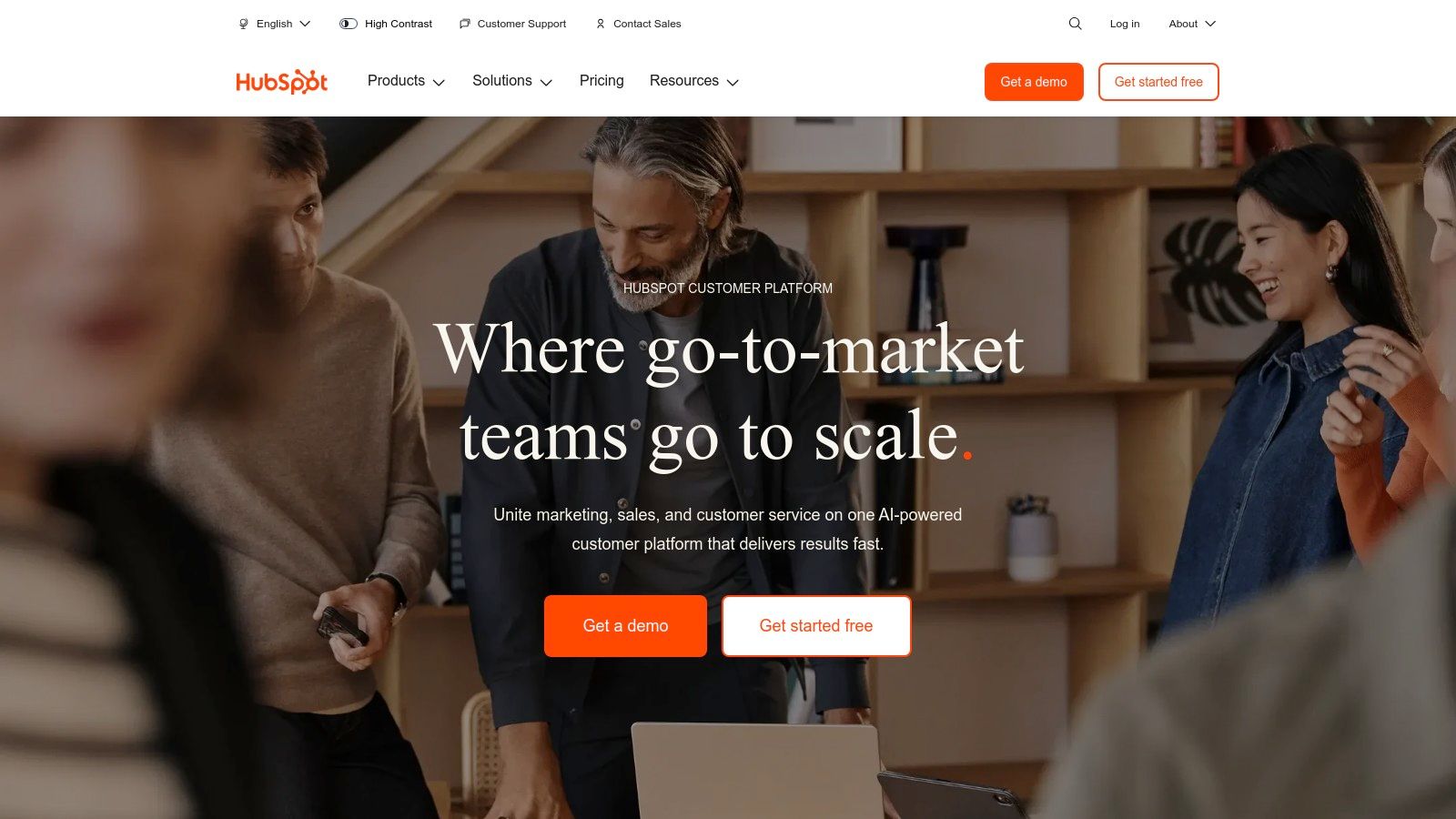
Key Features & User Experience
HubSpot is known for its clean, user-friendly interface, and the customer portal is no exception. The experience is straightforward for both clients and internal teams, focusing on clarity and ease of use over excessive customization.
- Ticket Management Portal: Clients can log in to view the status of their support tickets, respond to conversations, and review their entire ticket history in one place.
- Integrated Knowledge Base: Empower clients to find answers themselves by connecting your knowledge base directly to the portal.
- Shared Inbox & Live Chat: Unify all customer communications from email and live chat into a single shared inbox for faster, more organized responses.
- Custom Domain & Access: Host the portal on a custom domain and control which contacts get access, ensuring a secure and branded experience.
Pros and Cons
| Pros | Cons |
|---|---|
| Strong CRM integration provides a complete customer view. | The portal feature is only available on higher-tier paid plans. |
| Easy for SMBs to start with free tools and scale as they grow. | Seat-based pricing and potential onboarding fees can become costly. |
| Extensive integrations and excellent educational resources. | Less focused on file sharing or project management than competitors. |
Website: https://www.hubspot.com
8. Zendesk
Zendesk is a giant in the customer service space, and its platform includes a mature customer portal designed for support-driven interactions. While not a traditional project-based portal, it excels at creating a self-service hub where clients can find answers, submit support tickets, and track their requests. It’s built for organizations that prioritize efficient, scalable customer support over collaborative project management.
Its core strength is the seamless integration between its knowledge base, community forums, and ticketing system. This creates a powerful self-service ecosystem where customers can resolve issues independently or easily escalate them to an agent. For companies focused on reducing support tickets and improving customer satisfaction through information access, Zendesk offers one of the best client portal software solutions geared specifically for customer service and support teams.
Key Features & User Experience
Zendesk offers a polished and intuitive user experience that is fast to deploy. The interface is clean and focuses on helping users find information or get help quickly, minimizing friction for support-related tasks.
- Integrated Help Center: The portal is directly linked to a knowledge base, ticketing system, and community forums.
- Omnichannel Support: Engages customers via email, chat, phone, and social media, with AI-powered bots to provide instant answers.
- Robust Analytics: The Zendesk Explore feature provides deep insights into ticket volume, agent performance, and customer satisfaction.
- Large App Marketplace: Extends functionality with hundreds of pre-built integrations for CRMs, communication tools, and more.
Pros and Cons
| Pros | Cons |
|---|---|
| Scalable, enterprise-proven support stack. | Best suited to support workflows, not broad client project management. |
| Fast to deploy with a polished and intuitive user experience. | Total cost can rise significantly with add-ons and advanced analytics. |
| Rich AI and automation features available as add-ons. | Not designed for secure document collection or complex onboarding tasks. |
Website: https://www.zendesk.com
9. Onehub
Onehub is a secure client portal and workspace platform focused primarily on file sharing, collaboration, and virtual data rooms. It’s designed for businesses like financial firms, agencies, and legal practices that need to exchange sensitive documents with robust security, granular permissions, and detailed audit trails. Its strength lies in its simplicity and security-first approach to document management.
Instead of trying to be an all-in-one project management tool, Onehub excels at creating secure, branded workspaces for document exchange. This focus makes it a strong candidate for the best client portal software for organizations where secure file handling, watermarking, and access control are the top priorities over complex task management or invoicing features.

Key Features & User Experience
Onehub offers a clean, straightforward user interface that makes setup and navigation quick, even for non-technical users. The experience is centered around creating secure "Workspaces" where clients can upload, view, and comment on files.
- Branded Workspaces: Customize portals with your company logo, colors, and even a custom domain to create a professional client experience.
- Advanced Security: Features include role-based permissions, audit trails, dynamic watermarking, and a Virtual Data Room (VDR) edition with NDAs and stealth mode.
- Collaboration Tools: Includes full-text search, file versioning, and integrations with tools like DocuSign and Google Drive.
- FTP/SFTP Access: Provides secure, high-volume file transfer capabilities for power users and automated workflows.
Pros and Cons
| Pros | Cons |
|---|---|
| Strong document security with audit trails and watermarking. | Focused on files, not a complete end-to-end project workflow tool. |
| Straightforward pricing and a fast, simple setup process. | Some branding options and features cost extra on lower-tier plans. |
| External users often don’t count as paid users on certain plans. | Lacks integrated CRM, invoicing, or advanced task management. |
Website: https://www.onehub.com
10. Content Snare
Content Snare is a specialized platform designed to solve one of the biggest bottlenecks for service businesses: collecting information and documents from clients. It replaces endless email chains with a simple, structured process, making it popular with agencies, accountants, and legal professionals who rely on timely client submissions for onboarding and project kickoffs.
Its core strength is its laser focus on streamlining the collection process. Instead of offering a broad suite of business management tools, Content Snare excels at creating clear requests, sending automated reminders, and allowing clients to submit information without needing to create yet another account. This simplicity is why many consider it the best client portal software purely for intake and document gathering.
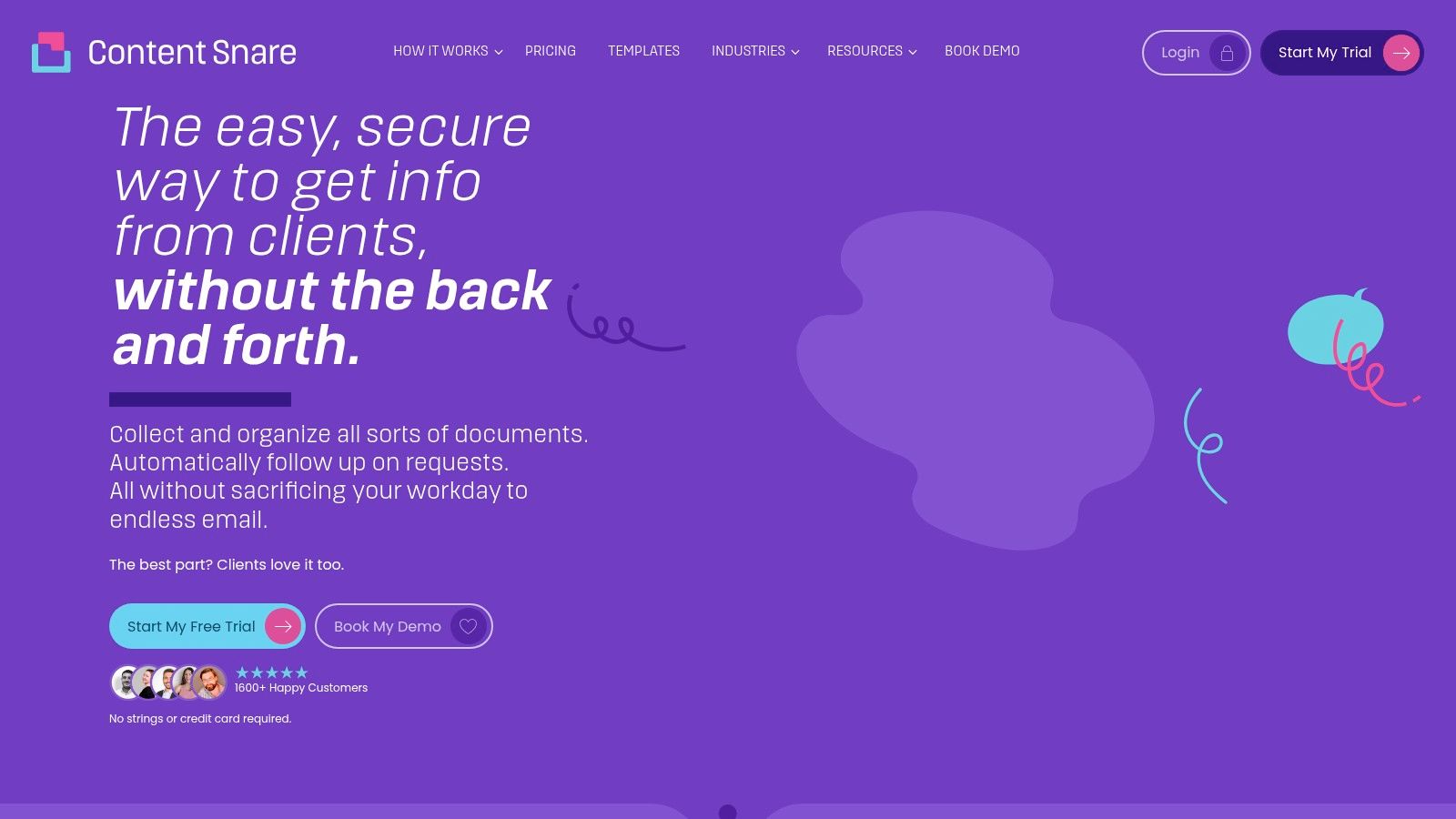
Key Features & User Experience
Content Snare’s user experience is clean and intuitive for both the business and the client, drastically reducing friction. The platform guides clients through exactly what is needed, field by field, which minimizes incomplete or incorrect submissions.
- Structured Requests: Create clear, sectioned-off requests for information and files, guiding clients through the process step-by-step.
- Automated Reminders: Set up a schedule of automated email reminders that chase up clients for you, saving significant administrative time.
- Client-Friendly Portal: Clients access a simple link to their request list without needing to create or remember login credentials.
- Templates & Approvals: Use pre-built templates for common requests and formally approve or request changes to client submissions. Learn more about different types of client document request software.
Pros and Cons
| Pros | Cons |
|---|---|
| Extremely easy for clients to use, reducing submission friction. | Narrow scope; it is not a full CRM or project management tool. |
| Automated follow-ups eliminate manual email chasing. | Pricing is based on active requests, which may limit high-volume users. |
| Strong fit for intake and onboarding document collection. | Not designed for ongoing client collaboration beyond initial collection. |
Website: https://contentsnare.com
11. G2 (Client Portal Software category)
G2 is not a client portal itself but a peer-to-peer review site and software marketplace that has become an essential research tool. Its dedicated Client Portal category allows you to compare dozens of vendors based on verified user reviews, feature sets, and market segments. It’s the go-to resource for validating marketing claims and understanding how a platform performs in real-world scenarios.
Its primary strength is the sheer volume of up-to-date, user-submitted data. Instead of relying on a vendor’s website, you can filter options by company size, user satisfaction ratings, and specific features to create a shortlist. This impartial approach makes it a critical first step in finding the best client portal software for your specific needs, helping you move from a broad search to a curated list of potential solutions.
Key Features & User Experience
The G2 platform is designed for research and comparison, offering powerful filters to narrow down the options. The user experience is straightforward, though the amount of data can be extensive.
- Verified User Reviews: Access a large database of recent, authentic reviews from users across different industries and company sizes.
- Comparison Grids: Compare up to four software products side-by-side on features, pricing models, and user satisfaction scores.
- Advanced Filtering: Drill down by features like compliance, white-labeling, or integrations to find software that meets your exact requirements.
- Market Reports: View G2 Grid Reports that rank vendors as Leaders, High Performers, Contenders, or Niche players based on market presence and user satisfaction.
Pros and Cons
| Pros | Cons |
|---|---|
| Large volume of recent and verified user reviews. | Sponsored placements can influence search results. |
| Powerful filters help create an unbiased shortlist. | Pricing information may not always be up-to-date. |
| Free to use for software buyers and researchers. | Requires cross-referencing with vendor sites for accuracy. |
Website: https://www.g2.com/categories/client-portal
12. Capterra (Portal/Client Portal software directory)
Capterra isn't a client portal itself but rather a comprehensive software directory that can be an invaluable starting point in your search. It lists over 200 different portal and client portal tools, allowing you to scan the market, compare features, and build a shortlist of potential vendors. For businesses unsure of where to begin, Capterra provides a bird's-eye view of the entire landscape.
Its value lies in its extensive filtering capabilities and verified user reviews. You can narrow down options based on specific features, pricing models, and business size, making it easier to find software that fits your exact needs. While many directories exist, Capterra’s long-standing reputation and detailed buyer guides make it a trusted resource for anyone researching the best client portal software and comparing mainstream and niche solutions.
Key Features & User Experience
The user experience is straightforward, designed for efficient research and comparison. You can quickly move from a broad category search to specific product pages, gathering key information along the way.
- Advanced Filtering: Sort software by features like document management, e-signatures, white-labeling, and pricing models (e.g., subscription, one-time license).
- Verified Reviews: Access reviews from real users, providing insights into the pros and cons of each platform from a customer's perspective.
- Comparison Tools: Directly compare up to four different products side-by-side on features, ratings, and pricing information.
- Buyer Guides: Offers regularly updated articles and guides that explain key features and help buyers make more informed decisions.
Pros and Cons
| Pros | Cons |
|---|---|
| Broad coverage of niche and mainstream tools in one place. | Some listings are generic "portal" software, not specific client portals. |
| Helpful for initial research, feature scanning, and shortlisting. | Users must visit vendor sites to confirm the latest pricing and features. |
| Free to use for research and comparison purposes. | Information can sometimes be outdated or based on vendor submissions. |
Website: https://www.capterra.com/portal-software/
Top 12 Client Portal Software Comparison
| Solution | Core features | UX / Quality | 💰 Price & Value | 👥 Target audience | ✨ Standout / USP |
|---|---|---|---|---|---|
| 🏆 Superdocu | Workflow builder, industry templates, branded portals, validation dashboard, Zapier & DocuSign | ★★★★★ — fast collection, mobile‑friendly | 💰 Starter €97/mo; Pro €247/mo; 7‑day trial — strong ROI (save 30+ hrs/mo) | 👥 SMBs, agencies, regulated teams (legal, real estate, HR, immigration) | ✨ GDPR + EU hosting, automated expirations, white‑labeling, deep integrations |
| SuiteDash | CRM, client portals, invoicing, e‑sign, projects, LMS | ★★★★☆ — feature‑rich, steeper learning curve | 💰 Flat pricing; unlimited clients & users — great all‑in‑one value | 👥 SMBs & agencies needing portal + ops in one platform | ✨ Broad single‑vendor toolkit, full white‑label |
| Clinked | Branded portals, mobile apps, 2FA, audit trails, integrations | ★★★★☆ — secure, mature mobile experience | 💰 Higher entry price; clear storage/member caps | 👥 Agencies, finance & professional services | ✨ Enterprise security (ISO 27001), watermarking, audit logs |
| Moxo | Drag‑drop workflows, portals, live chat, e‑sign, APIs/SDKs | ★★★★☆ — strong automation and compliance | 💰 Quote/seat pricing; add‑ons can increase TCO | 👥 Financial services, consulting, high‑touch firms | ✨ Private‑label apps, magic links, deep conditional logic |
| Ideagen Huddle | Branded spaces, co‑authoring, version control, granular perms | ★★★★☆ — enterprise collaboration & controls | 💰 Enterprise pricing by request; FedRAMP option | 👥 Regulated industries, public sector | ✨ Gov‑grade security (FedRAMP option), MS Office co‑editing |
| Salesforce Experience Cloud | Portals for cases, knowledge, automation, roles | ★★★★☆ — powerful with Salesforce expertise | 💰 Licensing by logins/named members; costs scale | 👥 Enterprises using Salesforce CRM | ✨ Native CRM linkage, AppExchange ecosystem |
| HubSpot Service Hub | Ticket portal, shared inbox, KB, automation & SLAs | ★★★☆☆ — SMB‑friendly; scales with paid tiers | 💰 Free tools; portal needs Professional/Enterprise (seat costs) | 👥 SMBs on HubSpot CRM | ✨ Easy CRM + helpdesk integration, strong onboarding |
| Zendesk | Help center, tickets, omnichannel, AI agents, analytics | ★★★★☆ — polished support UX, fast deploy | 💰 Tiered pricing; add‑ons raise total cost | 👥 Support‑centric teams, enterprises | ✨ Omnichannel support, AI assistants, rich analytics |
| Onehub | Branded workspaces, permissions, watermarking, VDR | ★★★★☆ — file‑centric, secure and straightforward | 💰 Clear plans; external users often don’t count up to limits | 👥 Agencies, finance, firms exchanging documents | ✨ Virtual data room features, stealth mode & NDAs |
| Content Snare | Client links, structured requests, deadlines, reminders, approvals | ★★★★☆ — very easy for clients; reduces email back‑and‑forth | 💰 Transparent tiers; active‑request limits apply | 👥 Agencies, accountants, onboarding teams | ✨ No‑account client links, intake‑focused automation |
| G2 (Client Portal category) | Category pages, reviews, comparisons, filters | ★★★★☆ — large, up‑to‑date review volume | 💰 Free to use for buyer research | 👥 Buyers shortlisting portal vendors, procurement | ✨ Verified reviews, buyer intent insights, side‑by‑side comparisons |
| Capterra (Portal directory) | Software directory, filters, buyer guides, reviews | ★★★★☆ — broad market coverage for scanning vendors | 💰 Free to use; vendor pricing links provided | 👥 Buyers researching and comparing portal options | ✨ Extensive listings, buyer guides & filters |
How to Choose the Right Client Portal for Your Business
Navigating the landscape of client portal software can feel overwhelming, but making the right choice boils down to clarity on your specific business needs. We've explored a wide range of powerful platforms, from all-in-one solutions like SuiteDash to specialized document collection powerhouses like Superdocu and Content Snare. We've also seen how established CRM giants like HubSpot and Salesforce are expanding into this space, offering integrated but often more complex options. Your journey to finding the best client portal software starts not with features, but with a clear understanding of your core problems.
The central theme connecting all these tools is the desire to replace chaotic email threads, insecure file sharing, and manual follow-ups with a streamlined, professional, and secure digital experience. For some, like legal or immigration firms, the non-negotiable features will be bank-grade security and compliance certifications. For others, like marketing agencies or real estate brokers, the ability to create a beautifully branded, intuitive client experience will be the top priority.
Your Action Plan: A Step-by-Step Guide to Selection
Instead of getting lost in feature comparisons, follow this structured approach to make an informed decision that benefits both your team and your clients.
-
Define Your Primary Use Case: Be honest about what you need most. Is it a secure vault for document exchange, a collaborative project management hub, or a customer support ticketing system? A tool that excels at document automation, like Superdocu, is fundamentally different from a support-focused platform like Zendesk. Listing your top three "must-have" functions will immediately narrow the field.
-
Map the Client Journey: Put yourself in your clients' shoes. Will they need to upload sensitive documents from a mobile device? Will they need to e-sign contracts? The best client portal software is one your clients will actually use. An overly complex system, no matter how powerful, will lead to frustration and a return to old, inefficient habits like email. Prioritize simplicity and ease of use from their perspective.
-
Audit Your Existing Tech Stack: Consider how a new portal will fit into your current ecosystem. Does it need to integrate seamlessly with your CRM, cloud storage (like Google Drive or Dropbox), or accounting software? Check the integration capabilities of your top contenders. A platform that connects with tools you already use will save significant time and prevent data silos.
-
Evaluate Security and Compliance: For industries like legal, finance, and HR, this is paramount. Investigate the platform's security protocols, data encryption standards (both in transit and at rest), and compliance with regulations like GDPR, SOC 2, or HIPAA. Don't just take their marketing claims at face value; look for official documentation or certifications.
-
Run a Real-World Trial: The single most important step is to take advantage of free trials. Don't just click around the demo environment. Shortlist two or three platforms and run a real (or simulated) client onboarding process through each one. This hands-on experience will reveal more about a platform's usability and true capabilities than any review ever could. Learning how to effectively evaluate software is a skill in itself. When exploring how to select the right business tools, it can be helpful to review how other 'best of' lists are curated. For example, consider this guide on the 12 Best Planning Apps to Organise Your Life in 2025 from Calendar0 to see how different evaluation criteria can be applied to software selection.
Ultimately, the best client portal software is the one that solves your biggest bottleneck, delights your clients, and gives you back valuable time. By focusing on your unique workflows and testing your top choices thoroughly, you can confidently invest in a tool that will become a cornerstone of your business operations and a key driver of client satisfaction.
Ready to transform your client onboarding and document collection? Superdocu is built specifically for businesses that need a simple, secure, and powerful way to gather information from clients without the email chaos. Start your free trial today and see how our automated workflows and branded portals can streamline your processes in minutes.
